ALL ABOUT PORTUGUESE CODFISH
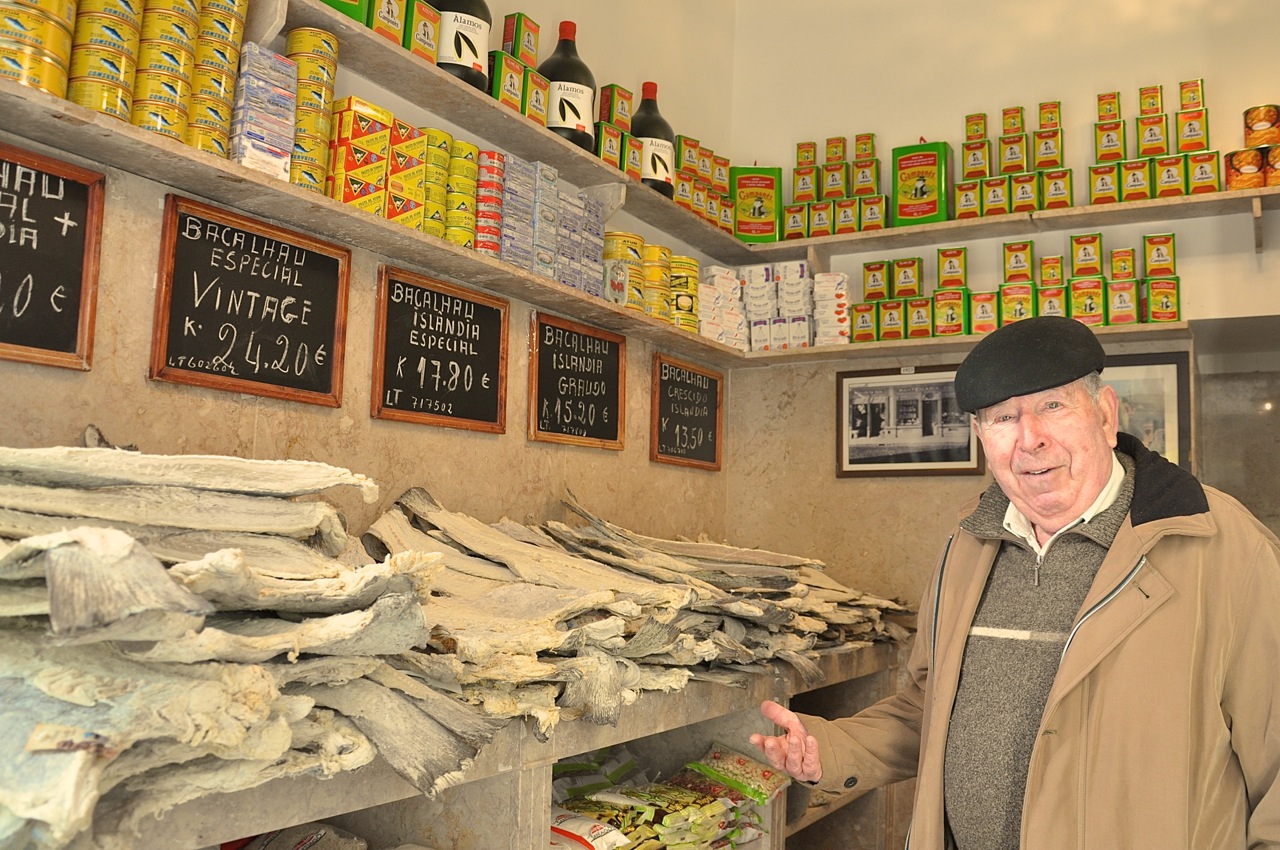
Portuguese salted codfish is a traditional ingredient deeply rooted in Portuguese eating habits. And it has been like this for the last five centuries. From the north to the south of Portugal, from east to west, from high-status families to the humblest homes, it’s everywhere!
And don’t think this is part of an old-fashioned Portuguese food tradition, kept only by our grandparents or parents’ generations! Portuguese salted cod is eaten regularly by adolescents and kids and they can even cook one of the 365 codfish recipes themselves. Portuguese codfish is one of these Portuguese typical foods you will find everywhere! Even outside Portugal!
Surprising facts about codfish in Portugal
During my year of voluntary work in Paris, in 2000, the city with most Portuguese migrants in Europe, I met some Erasmus Portuguese students at night, in bars. Among the funny cultural stories shared between international expats was the fact that, from time to time, a package would arrive from Portugal with what the family thought their ‘benjamim’ would need. And among several items what did we find? A big piece of dried and salted codfish, wrapped in plastic – certainly to avoid the smell – perfectly preserved, ready to be the king of a feast at the university residences.
In cod we trust!
First of all, how do we say codfish in Portuguese? Bacalhau is the magic word and once you say it in Portugal, everyone knows what you mean! You are referring to the Portuguese salted cod or Portuguese dried cod.
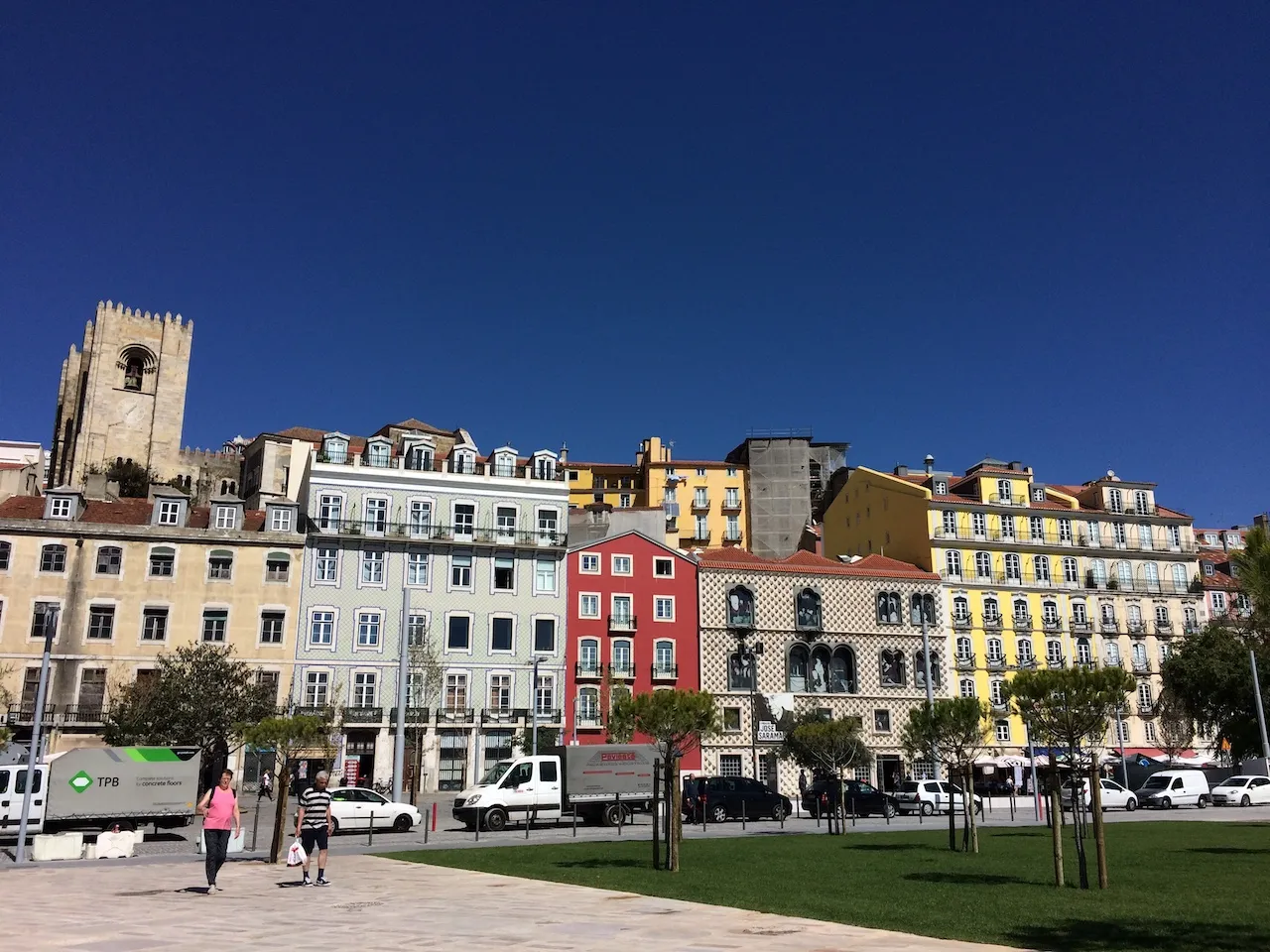
Bacalhoeiros Street in Lisbon
Every Portuguese restaurant has at least one dish made of codfish. At lunch or dinner, fried or poached, in a stew or a soup, traditional or with a contemporary twist… Options are unlimited for the best of our taste buds and we always find a traditional and tasty codfish recipe for a good price!
In supermarkets, food markets and stores, don’t be surprised by the smell, because also here, there’ll always be a place dedicated to codfish selling. We can find it stored in the corner of any food store, froze unsalted and ready to be cooked and there are even stores specially dedicated to the bacalhau, like Manteigaria da Silva, so no one can miss out on the national product.
Portugal is the world’s biggest consumer of cod, with 20 percent of all cod caught around the globe being eaten here, an average of 35 kilograms per person, per year!
Codfish, which earned the nickname of fiel amigo (faithful friend) in Portugal, it’s deeply connected to Portuguese heritage, culture and local cuisine. And it’s so important, that it’s even part of Oh! My Cod logo and name because, as we say in our food tours, it’s in cod that Portuguese trust!
You may think I am bluffing, but since 2005, I live in a street called Bacalhoeiros Street, in front of the river, which earned the name because of the several codfish houses that existed in this street during the 19th century.
Codfish chases me! Or am I chasing the codfish?
Bacalhau in Portuguese aka dried and salted codfish
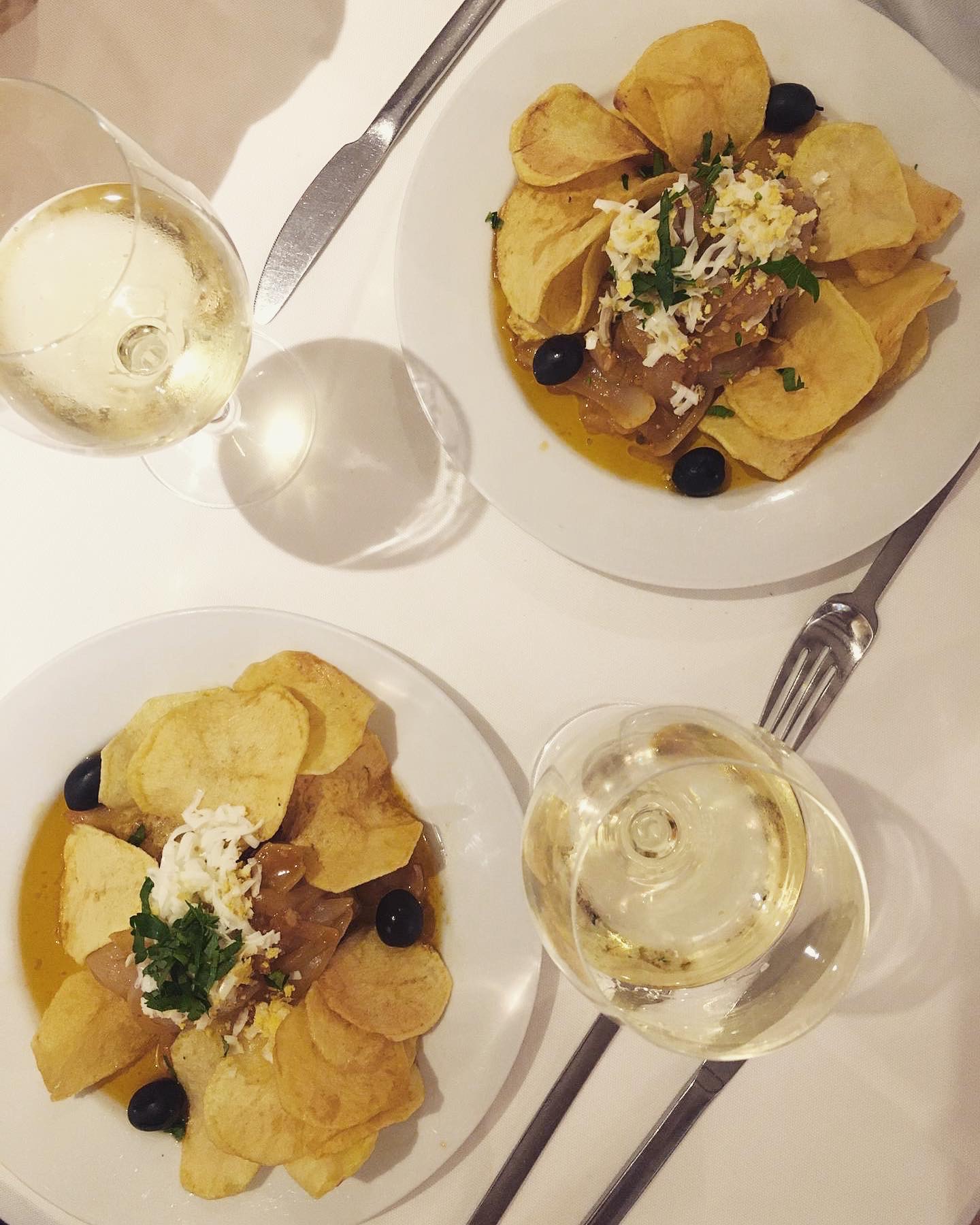
Codfish à Minhota at Sinal Vermelho restaurant
I keep writing about codfish, but in fact, as you already know I am referring to salted and dried codfish to be more specific. If you are in Portugal, when you say bacalhau, it’s implicit that you are referring to the salted and dried codfish. In fact, 95% of the codfish that Portuguese cook and eat is dried and salty. Only recently, during the last 10-20 years, the fresh codfish was introduced in the Portuguese restaurant menus, and often is associated with contemporary cuisine.
Since it’s dried we need to soak it in water to take out the salt which can take some time preparation, so if you want to impress your guest with a bacalhau meal make sure to plan your dinner!
Codfish was never a local Portuguese fish
First fact: the codfish Portuguese consume, Gadus Morue, never existed on the Portuguese coast. Surprised? The codfish we consume in Portugal lives in the colder waters and deeper sea regions throughout the North Atlantic, namely in North Carolina, Greenland, but also Iceland and Norvegian Coasts. Next time, in a shop, check the origin of the codfish to confirm it!
But again, when excellent fresh fish can be sourced along the extensive Portuguese Atlantic coastline and even in the Portuguese Azores islands (like the tuna), why do we bother to import this specific fish, salted and dried, and why is this traveled fish the Portuguese faithful friend?
The reason for this is deeply rooted in history and culture, including specific social and religious circumstances over the centuries.
Codfish in Portugal: a five centuries relationship
How codfish invaded Portugal?
To understand it we need to back 500 hundred years, to the pick of Portuguese sea discoveries.
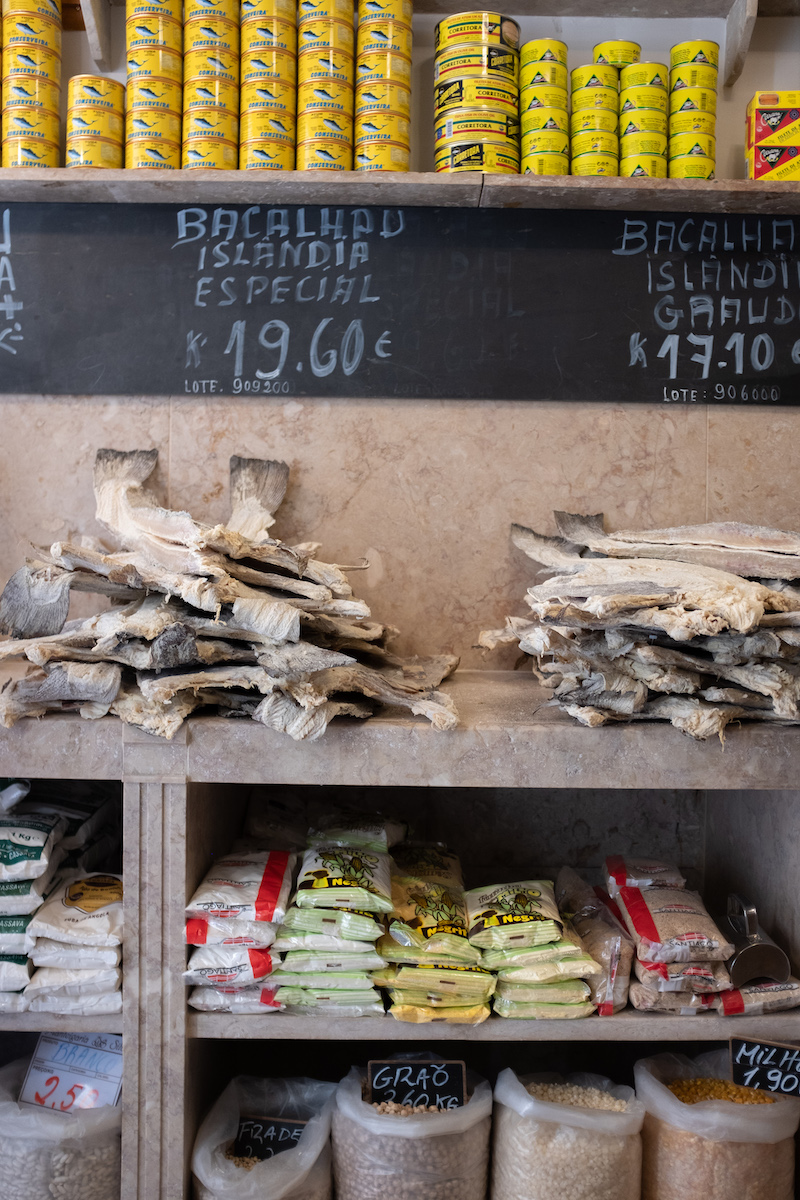
Codfish shop in Lisbon
The first records of Portuguese fleets fishing cod off the coast of Newfoundland date from the sixteenth century when the new maritime routes started food globalization.
As cod was fished in such far away (and cold) waters, preservation was a crucial factor. Salt was (and still is) a precious ingredient to preserve food – particularly when fridges were not yet invented – and Portugal had both the salt and extensive experience in salting and fish preservation (garum food tour).
When Portuguese sailors started bringing bacalhau back home, it was pickled in salt to withstand the long journey back home. Once it arrived at the Lisbon port it was salted and dried, plentiful and cheap.
But why codfish in particular? Well, it is especially interesting in terms of conservation since it has a low amount of fat, therefore the drying and salting process was found to be best with codfish for better conservation.
The origin behind the conservation methods dates back to the Vikings who used to dry the fish to conserve it. The second step is the salting process: the method is issued from the Roman empire and then the Basque people. To salt the dried fish allows it to conserve it longer and to facilitate its transport.
After centuries of long maritime trips, the preserved cod proved to be convenient for sailors. During 16th-17th century intercontinental crossings to Asia and Brazil bacalhau was eaten by these daring travelers with a strong sense of adventure.
The preserved fish that would soon provide the nutrition on voyages also played an important role during times when poverty took over Portugal due to economic instability and high taxes imposed by other nations.
Cod then became a portable source of nutrition, all over the country, from north to south, in the mountains and plains where the fish was scarce and it became firmly rooted in the national culinary identity, where it is still considered one of their most popular food staples – known as the “meat of the poor”.
Codfish, much more than a fish
Codfish, the ‘meat of the poor’, conquers the nobless
As we saw before, codfish became closely linked to Portugal’s history, a fish that we can fish easily and in big amounts, easy to conserve and transport. Codfish is a great nutritional product with nutritional intakes, rich in protein, minerals and vitamins, but was also an economic and humble product, then very appreciated by humble households.
But as we said codfish is the most eclectic ingredient in Portugal. Nowadays you can see it in any type of restaurant and any type of home independently of their economic status. So when exactly did this ingredient made its way to the noble tables and menus?
After the 16th century, the Portuguese crown decreased their investment in fishing fleets, to invest more in the African and Asian explorations. Associated with this fact, the raise of taxes associated with the expenses to finance these big sea enterprise/maritime endeavors, lead to the increase of the codfish price.
If the British Navy protected the Portuguese fishing fleets in exchange for salt (an extremely valuable asset at the time, and that Portugal produced in large quantities) later, they were a source of importation for the ‘English’ codfish which became the only in the Portuguese market in the 17th century (Amorim, 2004).
The demand for codfish provoked speculation and the fish was sold sometimes double of its original price in Lisbon.
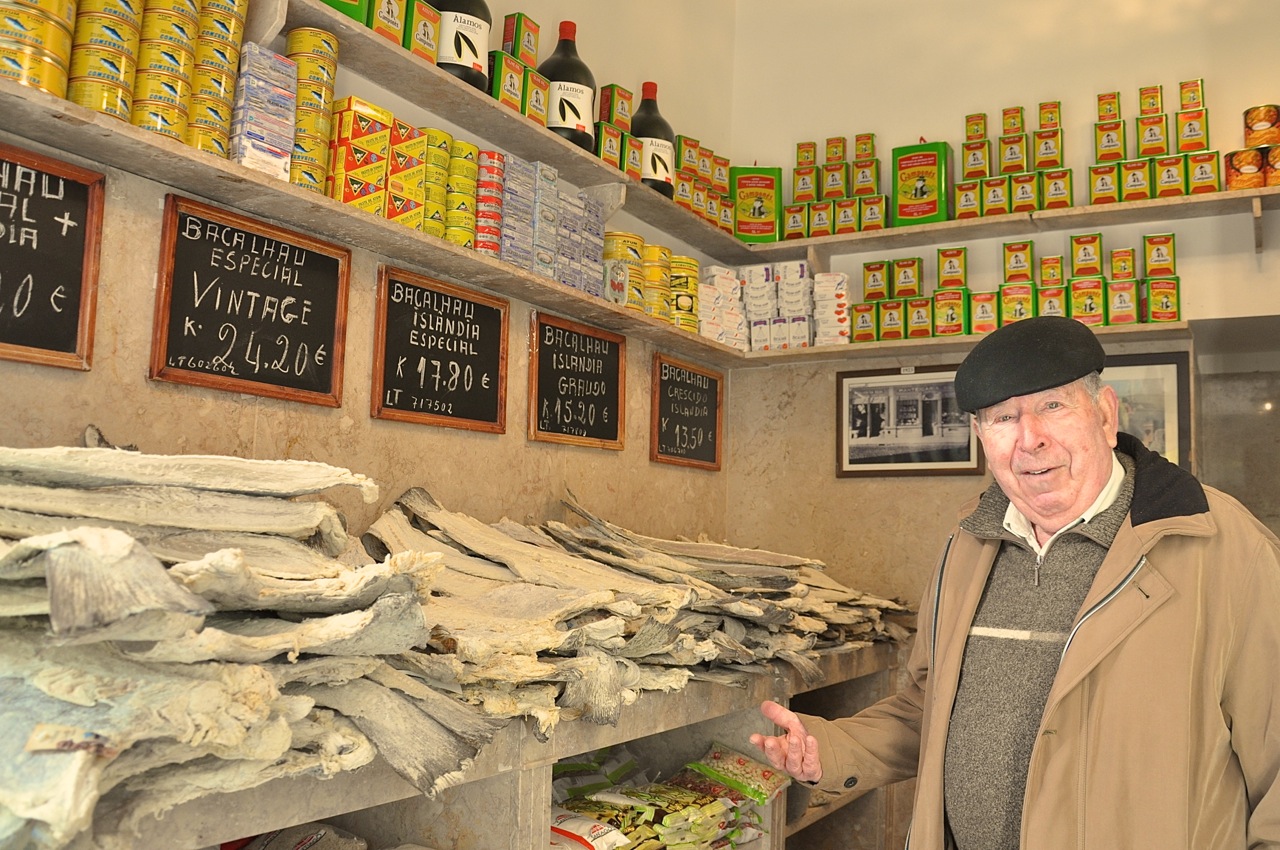
A local customer at Manteigaria da Silva during Oh! My Cod Food Cultural Tours
Once an expensive fish, codfish status also changed. Codfish was no longer the meat of the poor and started to invade the noble and the rich tables as well. In the 19th century, with the proliferation of restaurants, casas de pasto (eating houses), hotels the preparation of codfish had a qualitative leap.
Codfish became the most eclectic ingredient in Portugal. The fish of the rich and the poor. Was such a vital element that the bacalao trade dominated all of Portugal’s maritime commerce from 1737 to 1919. The 11% value-added sales tax was intended to be transferred from salt fisheries to protect cod fisheries. And while it only accomplished the first part, it did help develop systems for salting, drying and exporting fish worldwide by the 1800s!
Today, codfish price varies mainly according to the size and curing process. At Manteigaria da Silva you may see several piles of salted cod, normally from Iceland, which differ in price, being the vintage codfish, with 32-month of cure, the most expensive. This diversity informs us immediately how important, complex and deeply rooted in Portuguese cuisine bacalhau can be!
The main actor at the Portuguese religious tables
Another reason why this traveled fish is so rooted in Portuguese gastronomy is due to religious factors, deeply linked to an important catholic tradition in all of Portugal.
If one gathers all the days and periods on the Catholic calendar when meat consumption is forbidden – during Lent and on the fasting days – we will conclude that during one-third of the year Portuguese could not consume meat. Codfish, also named “the meat of the poors” was an excellent alternative to meat. It was easy to transport to every corner of Portugal – including mountains and the countryside – and a small piece of bacalhau was enough to give a delicious taste to a soup or a humble dish of vegetables and potatoes.
Flexibility is the keyword
There are recipes for all parts of the codfish, from tail to the checks and even the swim bladder (sames).
Some of them constitute very exquisite and refined recipes; others, like Sames com Xerém, could belong to the unusual foods of the world and seafood. This one, from the Alentejo region, is done with cod swim bladder and corn semolina. In Lisbon you can find it, sometimes, at some specific restaurants like Taberna do Calhau. But the flexibility of the codfish doesn’t end here!

Because its meat is very tasty, with just a small piece of cod, you can make a comforting and tasty meal, full of umami, like the Açorda à Alentejana. So it’s not astonishing if the codfish is the king of all tables, from wealthy to humble ones.
In Portugal, we say that we have at least 365 codfish recipes, one per day! Codfish consistency allows its meat all forms of cooking: boil, grill, fry, in stews or even raw (just marinated in lemon, in a black-eye bean salad for example, as we used to taste on 17 Tastings Lisbon Food Tour and the appealing fried codfish. Possibilities are endless!
Cook salted codfish as a Portuguese
How to choose codfish?
For a good codfish make sure first to check its origin. Best is the codfish from the Norwegian coasts or Canadian coast and the exact term that you would look for is Gadus morhua (de Norge).
Guidelines to choose your codfish:
Shape : triangular, in a delta shape
Texture : solid and hard, when holding it in your hand it must not bend
Size : preferably big and thick
Color : “ ivory” or pale straw color but never white which could signify the presence of additives (that we do not want !)
How to prepare codfish?
To prepare it, we slice the codfish in filets, wash it from the salt and we put it in a large container and cover it with very cold water, skin on top. We leave it in the fridge from 24h to 72h for big ones. Make sure to change the water every 6 hours to clean the fish from the salt. During this process, the codfish usually gains up to 30% of its volume.
How to cook codfish?
Then, to cook it you have a wide range of cooking methods and preparations. A simple way to cook it is to poach it in water; in a big casserole, cover the unsalted codfish with cold water and bring it to boil, then turn off the fire, cover it and let it rest for about 10 minutes. The best is not to over-boil it or it may lose its softness.
Codfish recipes along the Portuguese regions
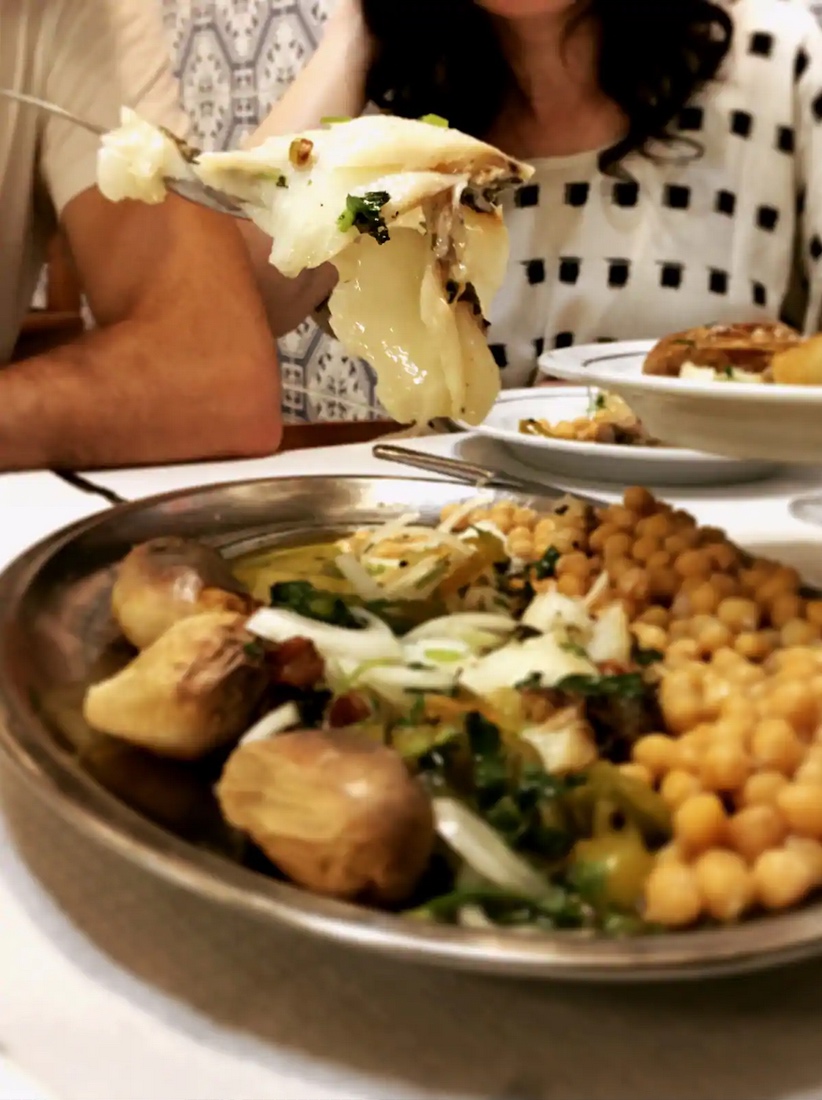
Salted cod in one of 17 Tastings Lisbon Food Tour stops
Almost any Portuguese codfish recipe can be considered a national dish of Portugal. Or at least, one among several Portuguese national dishes (let’s not forget my beloved Cozido à Portuguesa, which we will leave for another time). But as we said, we have at least 365 different ways to cook. We even eat Portuguese sandwiches with fried cod, like the delicious ones you can eat at Bifanas do Afonso (you thought we only had the bifana sandwich or the prego sandwich?). Street Portuguese food at its best!
Most codfish Portuguese recipes are prepared with popular and common products of the Portuguese land, namely potatoes, onions and garlic, olive oil and eggs but we can also identify some specificities according to the Portuguese regions.
In northern Portugal, in the Minho region we commonly find codfish in a Bacalhau à Narcisa recipe, a specialty of Braga – cooked in a pan with eggs, onions and potatoes and sprinkle with olives and baked in the oven. Close to the area, we can find in Porto the Bacalhau à Gomes de Sá speciality, this time the fried codfish (in a refogado with olive oil, onion and garlic) is cooked with potato and roasted in the oven. Going up northwest of the country, the rustic and mountainous land of Trás-os-Montes offers a specialty called Bacalhau à Vale da Porca – codfish slowly cooked with tomatoes, capers and olives.
In the central region and in most homes, Bacalhau com Todos is one of the Portuguese Christmas recipes. It’s a humble meal, meat-free – as required before Missa do Galo (Midnight Mass) – where the fish is boiled with cabbage and potatoes, and sometimes eggs and chickpeas. Heading to Lisbon, codfish is traditionally prepared in Bacalhau à Brás – codfish with onions, potatoes all in thin slices and cooked in a pan with eggs – and the delicious Pasteis de Bacalhau – the famous codfish cakes.
While in the south, in Alentejo, we found a regional specialty called Açorda de Bacalhau – a codfish soup with bread – and finally in Algarve we like to cook it in the Bacalhau à lagareiro style where this time the codfish is slowly cooked in the oven with peppers, for a fresh Mediterranean style.
Want to know more about cod? See this BBC short movie where Silvia Olivença, Oh! My Cod founder guides us through Lisbon streets and the local family business working with this Portuguese staple!
Feeling hungry? Why don’t you cook some codfish with our 10 Portuguese Cod Fish recipes step-by-step? Or, join our 17 Tastings Lisbon Food Tour, one of the best food and cultural experiences in Lisbon, and discover one of the most local places in Lisbon to eat fried codfish among other Portuguese traditional foods!
Article by :
Sílvia Olivença (anthropologist and food expert/CEO at Oh! My Cod Food Tours)
Elise Ridou (intern at Oh! My Cod Food Tours, on Sustainable Tourism, Master Degree from University UCO – South Britain, France)

